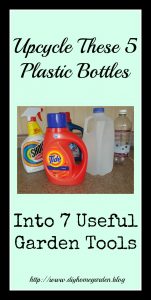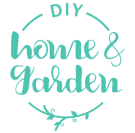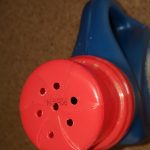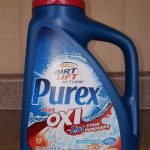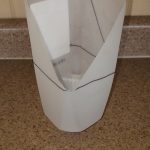I love that I can upcycle plastic bottles into useful garden tools. So today I show you how to take 5 plastic bottles and make 7 useful gardening tools out of them. I love recycling and try to upcycle anything that’s useful.
Here are six reasons why I choose to upcycle my plastic bottles.
- I need garden scoops, funnels, etc. anyways.
- I can use the upcycled tools for one season, then discard them at the end of the season to save storage space inside my barn.
- It saves a few dollars that I can put to use on other projects around the house.
- The plastic bottles are plentiful. For example, laundry detergent, milk, and white vinegar bottles. These products that we turn over in the house all the time.
- It reduces my carbon footprint.
- It’s easy and only takes a few minutes.
In fact, to prove how easy it was to upcycle plastic bottles. So I did just that. In all, it took less than 30 minutes to make seven garden tools. I dragged a 1-liter water bottle, a milk jug, two laundry jugs, and a trigger stain remover bottle out to my She-Shed and upcycled them into seven useful garden tools to use all summer long.
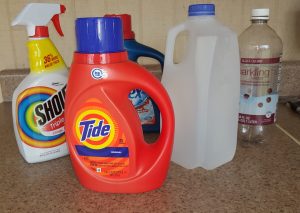
TOOL ONE: Trigger Spray Bottle
This is the simplest upcycle. So I guess it’s more of a recycle than an upcycle.
Firstly, I rinsed out the trigger bottle thoroughly. Then, I added about a teaspoon of regular Dawn dish soap and two tablespoons of plain white vinegar and filled it with warm water (to dissolve the Dawn). Lastly, I labeled it and will keep it on the sink in my She-Shed.
It comes in handy for all sorts of cleaning. For instance, cleaning my potting bench, sink, and outdoor patio furniture. Whether you call it a recycled plastic bottle or upcycled, I’ll take credit for keeping it out of the landfill.
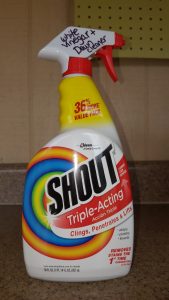
TOOL TWO: Measuring Cup
Ok, the first one was easy. So was this one. Several of my plant foods call for dissolving either 4 oz or 6 oz of product into water. I took a liquid measuring cup and poured in 6 oz of water–it went to the very top rim of the laundry detergent cap. I noted that the 4-ounce mark sat just above the 5 load line inside the cap.
I usually pick up a couple of measuring cups at yard sales in the spring, but I always lose them and need to buy more. Problem solved. I go through at least one Tide per month. Now I have placed this cap with my plant foods so I will have it handy.
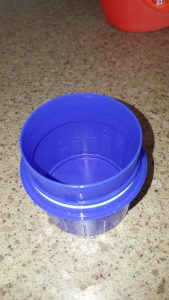
TOOL THREE: Watering Can
I used the second laundry detergent bottle to make a watering can. Then, I used a drill to make several holes in the cap. Finally, I drilled two small holes at the top of the handle to allow air in to push out the water.
TOOL FOUR: Funnel
My husband drives me crazy over funnels for his workshop. Because it seems like every time I buy a new set, he takes them outside and changes oil on his tractor and lawn mower with them. As a result, all my kitchen funnels eventually work their way out to his shop. I recently asked him why so many funnels, and he said they are easier to toss than to clean. Yikes!
So I purchased myself a nice new set of funnels that he’s strictly forbidden to take outside. Instead, I now save 1-liter water bottles and cut them in half for him. Remove the lid from the top half and it makes a perfect funnel.
I mark the bottle with a Sharpie so I know approximately where to cut. I use heavy-duty utility scissors to cut. For my disposable oil change funnels, I’m not too particular about the beauty of it. As long as it keeps my kitchen funnels in the house. Oy Vey!
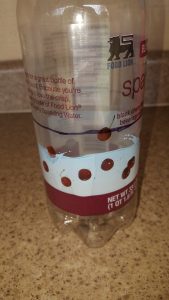
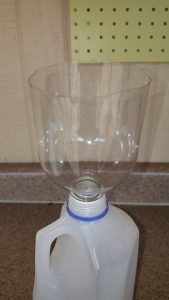
TOOL FIVE: Mini Terrarium or Seed Starting Container
Here in North Carolina, we have a fairly early planting season. However, we do get late frosts and hailstorms in the spring.
Remember the bottom half of the 1-liter water bottle?
“Waste not, want not”
You can use it to cover tender young plants from frost or hail. In addition, you can flip it upright, drill a couple of small holes and use it to move seedlings into after they outgrow their seed starting containers.
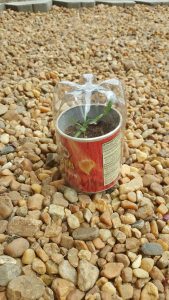
TOOL SIX: Garden Scoop
I need several garden scoops on hand. I use them for scattering birdseed, scooping lime or potting soil, and even to scoop up and flick away spiders. The scooping spider trick is far more effective than shrieking. Especially when the hubby’s not home to slay them for me.
Upcycle a 1/2 gallon milk container into a scoop and you will have a very handy tool.
First off, be very careful to rinse this well. You don’t want the souring milk smell to attract raccoons, possums, or eeeek…snakes to your garden!
I mark horizontally how “deep” I want the scoop to be. Then, diagonally mark off the two sides you want to cut away. You can also do it so the handle is on the top or on the bottom. Whichever way is more comfy for you is fine. I marked all sides to show you what I mean, then cut it the way I wanted it. Finally, I cut with those same heavy-duty utility scissors.
TOOL SEVEN: Carry-All For Garden Tools
Finally, the last upcycled plastic bottle tool is a carry-all container for my hand tools. I constantly find that as I move throughout the yard that I leave things behind. So, with this carry-all, I can keep my smaller tools organized and waste less time retracing my steps finding where I left things.
As gardeners, we need to have these tools on hand. So it only makes sense that we act as good stewards of our resources and upcycle plastic bottles into garden tools. You’ll have just the right tool at your fingertips, and you will save a few dollars, too!
